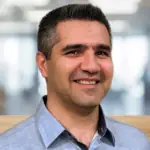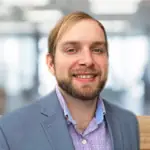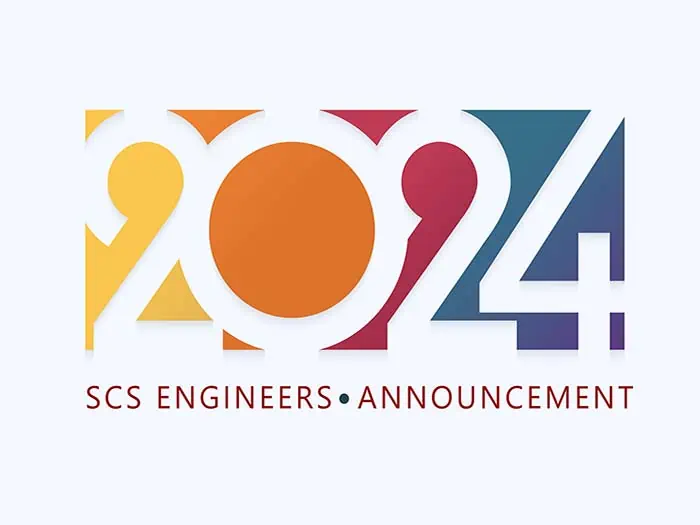

Dr. Charles Hostetler is presenting on Wednesday, February 28th (11:00 am – 11:30 am, Century).
“Pore Space Conflicts: Class VI Injection into Previously Utilized Pore Space”
Class VI projects (involving underground injection control (UIC) wells for the geologic sequestration of carbon dioxide) can have a surprisingly large footprint in terms of the lateral extent of pore space occupied by supercritical carbon dioxide as well as pressure increases in the injection zone. A limited amount of subsurface pore space is available in certain economically important sedimentary basins and there can be difficulties in finding unutilized pore space.
Interactions among neighboring UIC projects can be an important consideration in the scoping and design of Class VI projects. Class VI project design has largely focused on examining the extent of the subsurface supercritical carbon dioxide plume and ensuring access to and control over the pore space physically occupied by the plume. The pressure buildup during injection also influences subsurface pore space. The existence of pressure buildup from neighboring injection projects can be an important limitation in efficiently utilizing pore space resources across multiple projects.
In this study, we examine the factors that affect the injectability of a supercritical carbon dioxide stream near a preexisting Class I (liquid waste) UIC well. We consider the factors that influence the pressure distribution in the injection zone, such as the compressibility of water and supercritical carbon dioxide, the properties of the aquifer materials, and the geometry of the injection zone and injection wells. We conclude by summarizing the general factors that should be considered in project scoping and Area of Review delineation—additional authors: Kacey Garber and Lindsey Hawksworth, SCS Engineers.
Additional Resources:
SCS Engineers is participating in Auburn University 2024 Civil & Environmental + Biosystems Engineering ASCE/ASABE Career Fair on February 13, 2024.
This event is a great opportunity for all students and alumni to connect with a diverse array of employers, from corporations to nonprofits, for internships, part-time, and full-time positions.
SCS is an employee-owned, award-winning environmental engineering, consulting, and construction firm with offices nationwide. We are seeking a wide variety of dedicated, hard-working professionals with Science, Technology, Engineering, and Mathematics (STEM) backgrounds.
Students can register on Handshake.com
Capturing carbon dioxide and injecting it into a Class VI well for permanent geologic carbon sequestration, or CO2 storage, is a practice that industry leaders use to decarbonize manufacturing processes. Manufacturers use CO2 storage to reduce their greenhouse gas emissions and carbon footprint. There has been an uptick in proposed projects, both commercial hub-scale and single emitter-affiliated scale, particularly within the last year. The catalyst for the uptick in proposed projects is primarily the associated financial incentives, including federal tax credits and grant monies.
In this educational webinar, Professional Geologist Kacey Garber describes what manufacturers interested in geologic CO2 storage can expect the project landscape to look like in 2024. The video includes a discussion of the following:
Understanding the current project landscape and how and when future project opportunities might evolve is important for manufacturers considering the geologic storage of their CO2 stream, whether through a larger commercial hub or a smaller on-site project.
Additional Resources:
About the Presenter: Kacey Garber is a professional geologist experienced as a groundwater project manager for active and closed industrial client sites. Her responsibilities include groundwater monitoring and statistical analyses; reports and permit applications; designing sampling and analysis plans; special groundwater studies; and conducting groundwater well construction planning and design. She has also been involved in PFAS work groups and publishes on the topics of UIC and geologic carbon sequestration.
The U.S. Environmental Protection Agency (EPA) has launched a broad-ranging PFAS Strategic Roadmap aimed at effectively managing Per- and Polyfluoroalkyl Substances (PFAS) in diverse environments, including air, water, soil, and wastewater systems. This roadmap underscores the EPA’s commitment to addressing the challenges posed by PFAS, a group of synthetic chemicals extensively used in various industrial and consumer products for their resistance to heat, water, and oil.
While over 10,000 PFAS variants are known, only a small proportion are currently under regulatory scrutiny, with the number of regulated PFAS varying across countries and regions.
In the United States, the EPA concentrates regulatory and monitoring efforts on a select group of PFAS, primarily due to the scientific complexity of these compounds, analytical limitations, limited toxicity data, and the vast diversity of PFAS chemicals.
This SCS Engineers blog series, Navigating PFAS Compliance, delves into the regulations, management, and monitoring of PFAS at municipal solid waste (MSW) landfills, addressing environmental mediums including air, groundwater, wastewater (i.e., leachate), soil, and waste.
Landfill Regulations and Revisions Anticipated in 2024
Landfills are subject to various regulations, notably under the Resource Conservation and Recovery Act (RCRA) for both hazardous and non-hazardous waste, the Clean Air Act (CAA) for air emissions, and the Clean Water Act (CWA) for water resource protection. The Comprehensive Environmental Response, Compensation, and Liability Act (CERCLA), commonly known as Superfund, also plays a role in addressing contaminated landfill sites, particularly those that pre-date the promulgation of the RCRA Subtitle D program in the early 1990s.
Currently, RCRA does not have specific PFAS regulations for MSW landfills. However, the EPA is developing a rule to classify certain PFAS as “hazardous constituents” under RCRA. We anticipate the proposal in 2024.
Additionally, the EPA has already proposed listing two PFAS constituents – Perfluorooctanoic acid (PFOA) and Perfluorooctanesulfonic acid (PFOS) as hazardous substances under CERCLA, a move that could impact environmental cleanup and liability, particularly for landfills with releases impacting groundwater and adjacent areas. We anticipate the final CERCLA hazardous substances listing in 2024.
The EPA is also revising Effluent Limitation Guidelines to limit PFAS discharges into municipal wastewater treatment facilities. These include amending the Landfills Point Source Category ELGs under Effluent Guidelines Program Plan 15.
While research directly characterizing PFAS in landfill gas is limited, the presence of semi-volatile PFAS in municipal solid waste suggests their occurrence in landfill gas. The EPA is formulating regulations to control PFAS air emissions from multiple sources (e.g., LFG systems), with specific details yet to be fully established.
Federal and State Policies Evolve
The regulatory landscape for PFAS is swiftly evolving, with numerous states setting or updating PFAS standards to address emerging concerns and research findings. States like Alaska, Colorado, Delaware, Florida, Illinois, Indiana, Iowa, Maine, Michigan, Minnesota, Montana, Nevada, North Carolina, Pennsylvania, Rhode Island, Texas, Vermont, and Washington have implemented various PFAS standards.
Managing PFAS in landfills requires a comprehensive approach that includes advanced treatment technologies, compliance with changing regulations, continuous monitoring of the regulatory landscape, and, where necessary, remediation.
This SCS blog series will explore and report PFAS issues across each regulatory category impacting MSW landfills, offering insights into compliance, management, and regulatory aspects. Feel free to contact the authors with questions or comments; we’re here to help.
Additional Resources:
About the Authors: Connect with our authors and experts at


Kacey Garber, PG, is presenting on Wednesday, February 28th (8:30 am – 9:00 am, Plaza).
Kacey will answer the question, How Might Co-Mingling UIC Waste Plumes Affect Class I UIC Operations and the Area of Review?
Class I UIC wells may be utilized to dispose of fluid wastes within deep geologic units, such as depleted hydrocarbon reservoirs or saline aquifers. Class I UIC wells may be located in the vicinity of other injection wells associated with disposal and/or hydrocarbon production. Injecting fluids leads to mixing with and displacement of native fluids within the reservoir. Because water is relatively incompressible, the mixing and displacement of fluids lead to a buildup of pressure within the reservoir. The magnitude of this pressure buildup is dependent on several factors, including the porosity and permeability of the reservoir, the density and viscosity of both the previous and present-day injectate and native fluids, and the thickness and lateral extent of the reservoir.
Elevated reservoir pressures resulting from injection can allow fluids to migrate upwards through open or improperly plugged artificial penetrations and/or fractures of the reservoir or confining zones, either of which would endanger overlying aquifers. As a result, agencies require Class I UIC permit applications to include calculations or modeling to assess what pressure thresholds would lead to aquifer endangerment. Many of these calculations do not allow realistic predictions of pressure buildup or plume extent in situations where co-mingling of waste plumes may occur. In this presentation, we assess the utility of computational flow modeling for complex injection scenarios where the co-mingling of waste plumes from neighboring operations might influence pressure buildup and overall plume extent.
Kacey Garber is an experienced groundwater project manager for active and closed industrial clients, including routine groundwater monitoring and statistical analyses; reports and permit applications; designing sampling and analysis plans; special groundwater studies; and conducting groundwater well construction planning and design. She has also been involved in PFAS work groups and publishes on the topics of UIC and geologic sequestration. Ms. Garber has a Masters degree in Geoscience.
Additional Resources:
SCS Engineers is participating in the Georgia Tech ASCE/AEES 2024 Spring Civil and Environmental Engineering Career Fair on Thursday, February 1st, 2024.
Each year, Georgia Tech American Society of Civil Engineers (ASCE) and Association of Environmental Engineers and Scientists (AEES) co-host the Spring Civil and Environmental Engineering (CEE) Career Fair. This event is a great opportunity for all students and alumni to connect with a diverse array of employers, from corporations to nonprofits, for internships, part-time, and full-time positions. For company representatives who will be attending the career fair, this link contains valuable logistical information like times, parking, and table space details.
SCS is an employee-owned, award-winning environmental engineering, consulting, and construction firm with offices nationwide. We are seeking a wide variety of dedicated, hard-working professionals with Science, Technology, Engineering, and Mathematics (STEM) backgrounds.
Wastewater treatment is crucial to safeguard our water resources and the environment. Additionally, recycling wastewater is an excellent way to conserve this valuable resource, especially important for citizens and industry in the near future. At SCS Engineers, we specialize in the sustainable collection, treatment, and reuse of wastewater for municipalities and industries—our Landfill Leachate and Industrial Wastewater Treatment practice designs and implements these solutions.


SCS has a proven history of helping clients overcome their wastewater management issues. Treating and reusing wastewater is complex, but it is essential for many of our clients’ operations, sustainability objectives, and financial performance. With the addition of Kerim and Josh to SCS’s team, we have strengthened our technical expertise and capacity to tackle these challenges. ~ Nathan, Hamm, senior vice president and SCS’s national expert on Liquids Management.
This protocol applies to greenhouse gas reduction projects that divert eligible organic waste or agro-industrial wastewater streams that otherwise would have gone to uncontrolled anaerobic storage, treatment, and disposal systems (solid waste landfills, onsite anaerobic wastewater treatment facilities, etc.).
Projects that involve co-digestion of eligible organic waste streams with livestock manure are also eligible if they comply with the Livestock Project Protocol, diverting waste to a biogas control system (BCS). The protocol accepts several technologies, including:
Project Eligibility
The protocol stipulates the following requirements:
Project Exclusions
Protocol excludes the following activities:
Project Outcomes
A project is eligible to receive credits for ten years from the start date or until project activity is required by law. Applications for a second 10-year eligibility period are available. Only two AD facilities have registered with the Climate Action Reserve (CAR). CAR has awarded these projects a total of 224,655 CRTs, valued at approximately $700,000. In 2022, CAR awarded 22,257 CRTs to these projects. At a market price of $3.00/CRT, 22,257 CRTs have a value of $66,771.
Credit Feasibility
Understanding the technology and navigating protocol requirements can take time and effort. That’s where we come in. Contact SCS Engineers at or Greg McCarron on LinkedIn to learn how your project may qualify.
Additional Resources

SCS has a group of national experts working with all offices in North America to provide in-depth knowledge based on decades of experience supporting clients’ environmental needs. These resourceful people provide a wealth of information and guidance to support sustainable solutions in the industries SCS works in and with other professionals. Clients depend on the combination of SCS professional expertise, SCS leadership, and our roster of National Experts who consistently bring value to each solution. With the expanded leadership, SCS’s third generation can create even more sustainable solutions to environmental challenges. The firm announces its newest national experts as follows:








Over the years, SCS expanded and hired many talented people. They guide the firm, maintaining the founders’ focus and culture of adopting their clients’ environmental challenges as their own and fostering a culture of success for employees and communities.
The firm has won multiple awards for helping clients minimize waste generation, effectively managing recycling, collection, and disposal operations, renewable energy, safely cleaning up contaminated properties, protecting wastewater and groundwater, and cutting GHG emissions.
These employee-owners are most proud of the difference they make for their clients and communities as trusted partners. SCS clients entrust the firm with managing more than 35 million metric tons of anthropogenic CO2e greenhouse gases yearly. SCS collects and beneficially uses or destroys enough to offset greenhouse gas emissions from 7.4 million passenger cars annually. That’s more than any other environmental firm in North America.
Nicole Vogelpohl and Eva Luu attended the “Meet the Regulators” event hosted by A&WMA’s Golden West Chapter at the law firm Holland & Knight in San Francisco. It was an informative event where panelists Dr. Meredith Bauer, Hy Hinojosa, and Lisa Fasano, in for Viet Tran, from the Bay Area Air Quality Management District (BAAQMD), spoke about upcoming priorities, new organizational changes, current organizational issues, and project accomplishments. The three have recently been appointed new deputy executive officer positions at BAAQMD. They are open to taking things in a new direction regarding the permit process, communications with the public, and implementing new and upcoming methodologies for emerging analytical measurement technologies.
Environmental Justice and Air Quality
The panel discussed how, as we’ve learned and made continuous progress in air quality and local emissions reductions over the years, ozone (O3) is now less of a concern (for the Bay Area) compared to PM2.5, which now takes higher precedence as a pollutant of concern. Dr. Bauer and Lisa Fasano mentioned that in the grand scheme of things, we live in a region of great air quality; however, they acknowledge that while the greater San Francisco Bay Area has good air quality as a whole, there are always pockets of localized air pollution that need addressing. Areas specifically pointed out were marginalized communities, such as Bayview/Hunter’s Point and West Oakland. Coincidentally, SCS is currently involved in a project related to the SF Fire Department’s Training Facility moving from Treasure Island to Hunter’s Point. The goal is to ensure the air quality during their training burns will not have long-term downwind effects on the community.
Thorough Discussion Amongst the Panelists and Attendees — Permitting Backlog Issue
The current permitting system needs to be faster, and the backlog of processed permit applications poses challenges for new clients. Attendees expressed frustration and shared testimonies about their clients moving to different states due to the extensive permitting backlog and timely process, which has ultimately halted the emersion of some new regulatory technology and projects in the state. The regulators understand the current system needs reworking and prioritizing to ease and reduce the turnover time of the permit process.
Enlightening and Enjoyable
Hearing the regulators speak passionately about their roles, goals, and investment in the organization was truly pleasing. Thanks to Pat Sullivan for knowing and having worked with everyone we talked to; everyone said hi and spoke highly of you! At “Meet the Regulators,” we connected with stakeholders from local consulting firms, attendees from the petroleum, tech, and waste management industries, and regulators – or, as Dr. Bauer renamed the group, the communicators, to help bridge the gap between the governing board and the general public.
Additional Resources